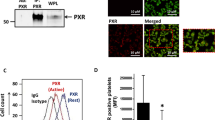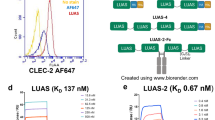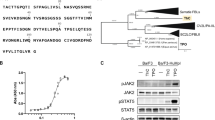Abstract
THROMBOXANE A2 is a very unstable arachidonate metabolite, yet a potent stimulator of platelet aggregation and a constrictor of vascular and respiratory smooth muscles1. It has been implicated as a mediator in diseases such as myocardial infarction, stroke and bronchial asthma2. Using a stable analogue of this compound we recently purified the human platelet thromboxane A2 receptor to apparent homogeneity3. Using an oligonucleotide probe corresponding to its partial amino-acid sequence, we have obtained a complementary DNA clone encoding this receptor from human placenta and a partial clone from cultured human megakaryocytic leukaemia cells. The placenta cDNA encodes a protein of 343 amino acids with seven putative transmembrane domains. The protein expressed in COS-7 cells binds drugs with affinities identical to those of the platelet receptor, and that in Xenopus oocytes opens Ca2+-activated Cl- channel on agonist stimulation. Northern blot analysis and nucleotide sequences of the two clones suggest that an identical species of the thromboxane A2 receptor is present in platelets and vascular tissues. This first report on the molecular structure of an eicosanoid receptor will promote the molecular pharmacology and pathophysiology of these bioactive compounds.
This is a preview of subscription content, access via your institution
Access options
Subscribe to this journal
Receive 51 print issues and online access
$199.00 per year
only $3.90 per issue
Buy this article
- Purchase on Springer Link
- Instant access to full article PDF
Prices may be subject to local taxes which are calculated during checkout
Similar content being viewed by others
References
Samuelsson, B. et al. A. Rev. Biochem. 47, 997–1029 (1978).
Ogletree, M. L. Fed. proc. 46, 133–138 (1987).
Ushikubi, F. et al. J. biol. Chem. 264, 16496–16501 (1989).
Nakajima, M. et al. Biochem. biophys. Res. Commun. 158, 958–965 (1989).
Ogura, M. et al. Blood 66, 1384–1392 (1985).
Kyte, J. & Doolittle, R. F. J. molec. Biol. 157, 105–132 (1982).
Strader, C. D. et al. J. biol. Chem. 263, 10267–10271 (1988).
Frndlay, J. B. C. & Pappin, D. J. C. Biochem. J. 238, 625–642 (1986).
Franke, R. R., Sakmar, T. P., Oprian, D. D. & Khorana, H. G. J. biol. Chem. 263, 2119–2122 (1988).
Wong, S. K-F., Parker, E. M. & Ross, E. M. J. biol. Chem. 265, 6219–6224 (1990).
Avdonin, P. V., Svitina-Ulitina, I. V., Leytin, V. L. & Tkachuk, V. A. Thromb. Res. 40, 101–112 (1985).
Houslay, M. D., Bojanic, D. & Wilson, A. Biochem. J. 234, 737–740 (1986).
Brass, L. F., Shaller, C. C. & Belmonte, E. J. J. clin. Invest. 79, 1269–1275 (1987).
Murray, R. & FitzGerald, G. A. Proc. natn. Acad. Sci. U.S.A. 86, 124–128 (1989).
Seed, B. Nature 329, 840–842 (1987).
Ushikubi, F. et al. Eicosanoids 2, 21–27 (1989).
Hanasaki, K. et al. Biochem. biophys. Res. Commun. 150, 1170–1175 (1988).
Arita, H., Nakano, T. & Hanasaki, K. Prog. Lipid. Res. 28, 273–301 (1989).
Masu, Y. et al. Nature 329, 836–838 (1987).
Lefer, A. M. et al. proc. natn. Acad. Sci. U.S.A. 77, 1706–1710 (1980).
Mais, D. E. et al. J. Pharmac. exp. Ther. 233, 418–424 (1985).
Swayne, G. T. G. et al. Eur. J. Pharmac. 152, 311–319 (1988).
Narumiya, S., Okuma, M. & Ushikubi, F. Br. J. Pharmac. 88, 323–331 (1986).
Coleman, R. A., Kennedy, I., Humphrey, P. P. A., Bunce, K. & Lumley, P. in Comprehensive Medicinal Chemistry (eds Hansch, C., Sammes, P. G., Taylor, J. B. & Emmett, J. C.) vol. 3, 643–714 (Pergamon, Oxford, 1989).
Frielle, T. et al. Proc. natn. Acad. Sci. U.S.A. 84, 7920–7924 (1987).
Regan, J. W. et al. Proc. natn. Acad. Sci. U.S.A. 85, 6301–6305 (1988).
Kubo, T. et al. Nature, 323, 411–416 (1986).
Yokota, Y. et al. J. biol. Chem. 264, 17649–17652 (1989).
Ausubel, F. M. et al. (eds) Current Protocols in Molecular Biology. 9.2.5 (Wiley, New York, 1989).
Author information
Authors and Affiliations
Rights and permissions
About this article
Cite this article
Hirata, M., Hayashi, Y., Ushikubi, F. et al. Cloning and expression of cDNA for a human thromboxane A2 receptor. Nature 349, 617–620 (1991). https://doi.org/10.1038/349617a0
Received:
Accepted:
Issue Date:
DOI: https://doi.org/10.1038/349617a0
This article is cited by
-
Prostaglandin and prostaglandin receptors: present and future promising therapeutic targets for pulmonary arterial hypertension
Respiratory Research (2023)
-
G-Protein-Coupled Receptors and Ischemic Stroke: a Focus on Molecular Function and Therapeutic Potential
Molecular Neurobiology (2021)
-
Molecular mechanisms underlying the actions of arachidonic acid-derived prostaglandins on peripheral nociception
Journal of Neuroinflammation (2020)
-
Targeting lipid mediators in cancer biology
Cancer and Metastasis Reviews (2018)
-
The renal vasodilatory effect of prostaglandins is ameliorated in isolated-perfused kidneys of endotoxemic mice
Pflügers Archiv - European Journal of Physiology (2018)
Comments
By submitting a comment you agree to abide by our Terms and Community Guidelines. If you find something abusive or that does not comply with our terms or guidelines please flag it as inappropriate.



